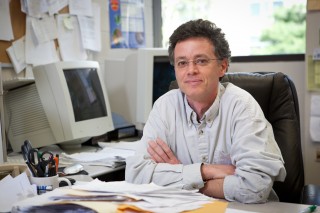Dec 13 2013
New research at the University of Arkansas shows that behavior can be predicted and understood in thin films made of materials called relaxors, which can be used in electronic devices.
 Laurent Bellaiche. Credit: Russell Cothren, University of Arkansas
Laurent Bellaiche. Credit: Russell Cothren, University of Arkansas
Physicists Sergey Prosandeev and Laurent Bellaiche, with Dawei Wang at Xi’an Jiaotong University in China, report their findings in an article titled “Properties of epitaxial films made of relaxor ferroelectrics,” in current issue of the journal Physical Review Letters.
Prosandeev and Bellaiche study ferroelectric materials, which convert small changes in mechanical energy into electrical energy, called a piezoelectric response, and are used in a wide range of applications that includes injectors in vehicles and heart implants.
In this study, the team used supercomputers at the Arkansas High Performance Computing Center to perform calculations on thin films made of a certain type of complex ferroelectrics — called relaxors — that were deposited on different substrates.
Their conclusions suggest how their properties could be controlled.
“One advantage of thin films is that they can be grown on different substrates, which makes their distance between atoms identical to those of the substrate,” said Bellaiche, a Distinguished Professor of physics. “If you change the substrate, you change the distance between atoms in the films. We discovered what happens to the physical properties — both microscopic and macroscopic — when doing so.”
The authors put forward a phase diagram that will help scientists design new transducers and other devices made of relaxor thin films, said Prosandeev, a research professor of physics.
“This study is important for experimentalists who grow piezoelectric films and look for new thin films that possess desired properties that are important for our daily life and technology,” Prosandeev said. “This study opens a new direction in the understanding of the properties of disordered piezoelectric thin films.”
Bellaiche holds the Twenty-First Century Endowed Professorship in Nanotechnology and Science Education. Prosandeev and Bellaiche are both in the University of Arkansas’ Institute for Nanoscience and Engineering.